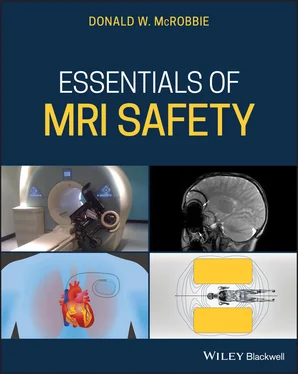14 Chapter 14Table 14.1 Summary of training requirements for categories of staff. Adapted ...Table 14.2 IEC patient exposure limits for each Operating Mode [25].
15 Appendix 1Table A1.1 Demagnetizing factors for various geometries. d 1is for the princi...
1 Chapter 1 Figure 1.1 The electromagnetic spectrum showing frequency and wavelength of ... Figure 1.2 MRI adverse events reported to the FDA. Data from [3]. Figure 1.3 Nuclear magnetism: (a) basis state energy differences; (b) format... Figure 1.4 Excitation of the macroscopic magnetization Mby the B 1RF field.... Figure 1.5 B zfrom magnetic field gradients G xand G y. Figure 1.6 Multiple slice imaging. Changing the frequency of each RF pulse w... Figure 1.7 Simple 2D pulse gradient echo (GRE) sequence showing pulse amplit... Figure 1.8 3D imaging sequence with a second phase‐encode gradient in the sl... Figure 1.9 Gradient echo images: Gradient echo (GRE) abdomen; Rapid Acquired... Figure 1.10 Spin echo formation: following a 90° pulse aligned with the x’ a... Figure 1.11 Spin echo images: (a) Spin echo (SE) T 2‐weighted brain; single s... Figure 1.12 Schematic of principal MRI system components: DAC is digital‐to‐... Figure 1.13 MRI operator’s console in the control room with observation wind... Figure 1.14 Superconductivity: (a) resistance v temperature for a supercondu... Figure 1.15 Schematic of a self‐shielded superconducting MRI system. Figure 1.16 Trapezoidal gradient pulse. Figure 1.17 Transmit 8‐rung ‘birdcage’ coil to produce a circularly polarise... Figure 1.18 IEC 60601‐2‐33 [4] compliant coil labelling: left‐ transmit only... Figure 1.19 Parallel transmit: two (or more) independent RF power amplifiers... Figure 1.20 Receive coil and pre‐amplifier: (a) the coil has inductance L an... Figure 1.21 Relative magnitude of magnetic fields used in MRI. Figure 1.22 Definition of the SI unit tesla. Figure 1.23 Magnetic field lines of force: (a) seen in the pattern of iron f... Figure 1.24 Fringe field contours at 0.5, 1, 3, 5, 10, 20, 40 and 200 mT for... Figure 1.25 The magnitude of the B 0fringe field (solid lines, logarithmic L... Figure 1.26 Simulated electric (L) and magnetic fields (R) from an eight‐run... Figure 1.27 RF pulse consisting of the carrier (Larmor) frequency multiplied... Figure 1.28 (a) the RMS value of a sinusoid is the peak amplitude divided by... Figure 1.29 MR device labeling according to ASTM‐F2503 (IEC‐62570) [6]. The ...
2 Chapter 2 Figure 2.1 Electric field lines begin at a source of positive charge and ter... Figure 2.2 Magnetic field lines from a permanent bar magnet. Figure 2.3 Electric fields induced by a time‐varying magnetic field form com... Figure 2.4 Electromagnetic wave: the magnetic and electric fields are orthog... Figure 2.5 Magnetic field lines from a long straight conductor carrying curr... Figure 2.6 Relative magnitude of B zalong the z‐axis for a long straight wir... Figure 2.7 Solenoid coil showing the angle θ. For a very long solenoid θ →90... Figure 2.8 B and dB/dt along the axis of a simulated shielded and unshielded... Figure 2.9 Magnetic susceptibility spectrum. Figure 2.10 Domains in a ferromagnetic material as the external field is inc... Figure 2.11 B‐H curve for 416 stainless steel (blue line) and its magnetic p... Figure 2.12 The hysteresis curve for a ferromagnetic material. The orange li... Figure 2.13 Demagnetization field within objects magnetized by an external m... Figure 2.14 Reciprocal demagnetization factors for a cylinder: 1/d 1(axial, ... Figure 2.15 Predicted internal B for a ferromagnetic sphere and cylinders of... Figure 2.16 B, dB/dz and product B .dB/dz along the z‐axis for: (a) a shielde... Figure 2.17 Predicted translational force (logarithmic scale) on spherical a... Figure 2.18 Influence of angulation of ferromagnetic objects with respect to... Figure 2.19 Predicted translational force on spherical and cylindrical 0.1 k... Figure 2.20 Predicted projectile velocity for the objects and magnets in Fig... Figure 2.21 Torque Τ on a ferromagnetic object of length l. The force on eit... Figure 2.22 Relative torque as a function of: (a) angle; (b) ratio of length... Figure 2.23 Predicted torque for ferromagnetic 0.1 kg objects of varying l/d... Figure 2.24 Predicted maximum twisting force (solid lines) and translational... Figure 2.25 The Lorentz force on a straight conductor with (a) B into the pa... Figure 2.26 Magneto‐hydrodynamic and Hall effect. Figure 2.27 Ohm’s law in a circuit and a volume conductor. Figure 2.28 B 1uniformity map for a head phantom at 7 T showing the effect o... Figure 2.29 Field regions in air and within the patient’s tissues. In the in... Figure 2.30 Measurements of B 1and E 1in a gel phantom on axis and off‐axis ...
3 Chapter 3 Figure 3.1 Magnetic forces in biology: (a) Hall effect; (b) Lorentz force; (... Figure 3.2 Relative strength of forces on molecules and ions. Figure 3.3 (a) Magneto‐hydrodynamic (Hall effect) artefact on an MRI ECG tra... Figure 3.4 Number of published studies of bio‐effects of static magnetic fie... Figure 3.5 Reactive oxygen species (ROS) results from in‐vitro studies. Deri... Figure 3.6 Magnetic field dependence of the kinetics of flavin oxidation in ... Figure 3.7 Acute sensory effects reported in the Netherlands occupational ex... Figure 3.8 Nystagmus caused by 7 and 3 T static magnetic fields: blue dots =... Figure 3.9 Temporal response of nystagmus at 7 T: horizontal movement (blue ... Figure 3.10 Vertigo and nystagmus: (a) B field variation with time showing o...
4 Chapter 4Figure 4.1 Early phosphene research: (a) Charles Le Roy’s “cure for blindnes...Figure 4.2 Induced E‐field and current density J from a uniform time‐varying...Figure 4.3 Induced E‐field and current density J in an elliptical cross sect...Figure 4.4 B and dB/dt magnitude for G zrelative to a supine patient. dB/dt ...Figure 4.5 Variation of B and dB/dt from gradients G x, G y, and G z. Field mag...Figure 4.6 (a) A uniform magnetic flux density B z; the strength of the field...Figure 4.7 Modelling of induced electric fields: (a) from the y‐coil for dB/...Figure 4.8 Magneto‐phosphene threshold v frequency; data from various source...Figure 4.9 Strength duration curve showing the rheobase (the minimum thresho...Figure 4.10 (a) Structure of a myelinated nerve axon; (b) electrical, transm...Figure 4.11 Nerve ion dynamics (a) at rest; (b) during excitation; (c) and t...Figure 4.12 Linearizing of the SD curve in terms of ΔB. The exponential form...Figure 4.13 Fitted exponential and hyperbolic SD curves to real data from to...Figure 4.14 Increasing the stimulus strength above the threshold to a supram...Figure 4.15 Waveform dependence: bi‐phasic or bipolar stimuli display lower ...Figure 4.16 Stimulation a very high frequencies (very short period stimuli):...Figure 4.17 A combined SD curve for ΔB using published PNS data for MRI (Tab...Figure 4.18 Population response for PNS from MRI gradients for three levels ...Figure 4.19 Gradient specification formulation of the SD curve showing areas...Figure 4.20 Combined for all gradients dB/dt from different sequences: BOLD ...Figure 4.21 Effective stimulus durations (t s,eff) defined in IEC‐60601‐2‐33 ...Figure 4.22 IEC limits for peripheral nerve and cardiac stimulation [34].Figure 4.23 Bio‐effects spectrum showing the principal sensory effects and f...
5 Chapter 5Figure 5.1 Relative energies: 128 MHz RF photon 8.48×10 −26J; 100 kV pd...Figure 5.2 Tissue conductivity (solid lines) and relative permittivity (dash...Figure 5.3 SAR hotspot formation due to electrical properties for idealised ...Figure 5.4 Human body models in a 1.5 T whole‐body RF coil (shaded region): ...Figure 5.5 Temperature increase versus time for various tissues exposed to a...Figure 5.6 Nett power absorption differences with age: the red bars indicate...Figure 5.7 Effect of ambient temperature on radiative cooling rates.Figure 5.8 Temperature regulation. TNZ is temperature neutral zone. Below LC...Figure 5.9 CEM43: (a) Cumulative equivalent minutes at 43 °C for damage to v...Figure 5.10 Skin anatomy.Figure 5.11 RF burns: (a) from inappropriate ECG electrodes.Figure 5.12 RF conduction paths. Crossing legs at ankle level increases the ...Figure 5.13 SAR derating for the First Level Controlled Mode for ambient tem...Figure 5.14 SAR reduction: flip angle and RF pulse type. Changing the RF pul...Figure 5.15 SAR reduction: the relative reduction in SAR (with respect to TR...Figure 5.16 Hyperechoes use a train of small flip angle pulses with variable...
Читать дальше












